Comparing PLC and LTD: SWOT Analysis and Stakeholder Views
VerifiedAdded on 2021/02/20
|10
|1346
|153
Report
AI Summary
This report provides a comparative analysis of Public Limited Companies (PLCs) and Private Limited Companies (LTDs), highlighting their key differences in terms of share offerings, legal requirements, member limitations, and market scope. The report includes a SWOT analysis of Unilever and ASDA, examining their strengths, weaknesses, opportunities, and threats. It also explores stakeholder perspectives, including investors, customers, suppliers, and government, assessing how these companies manage relationships with various stakeholders. The analysis demonstrates the distinct advantages and disadvantages of each company structure and their impact on business operations and stakeholder satisfaction.
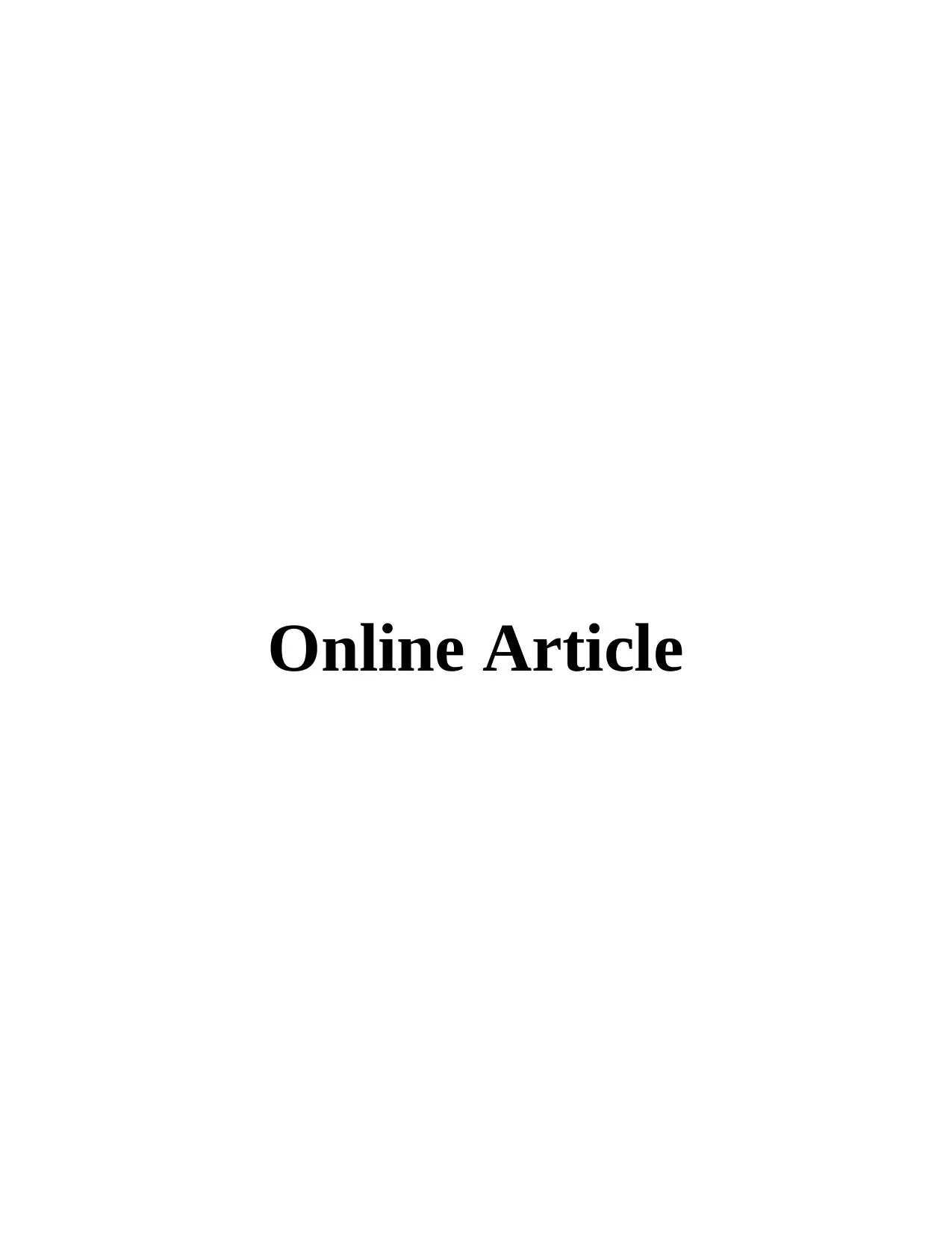
Online Article
Paraphrase This Document
Need a fresh take? Get an instant paraphrase of this document with our AI Paraphraser
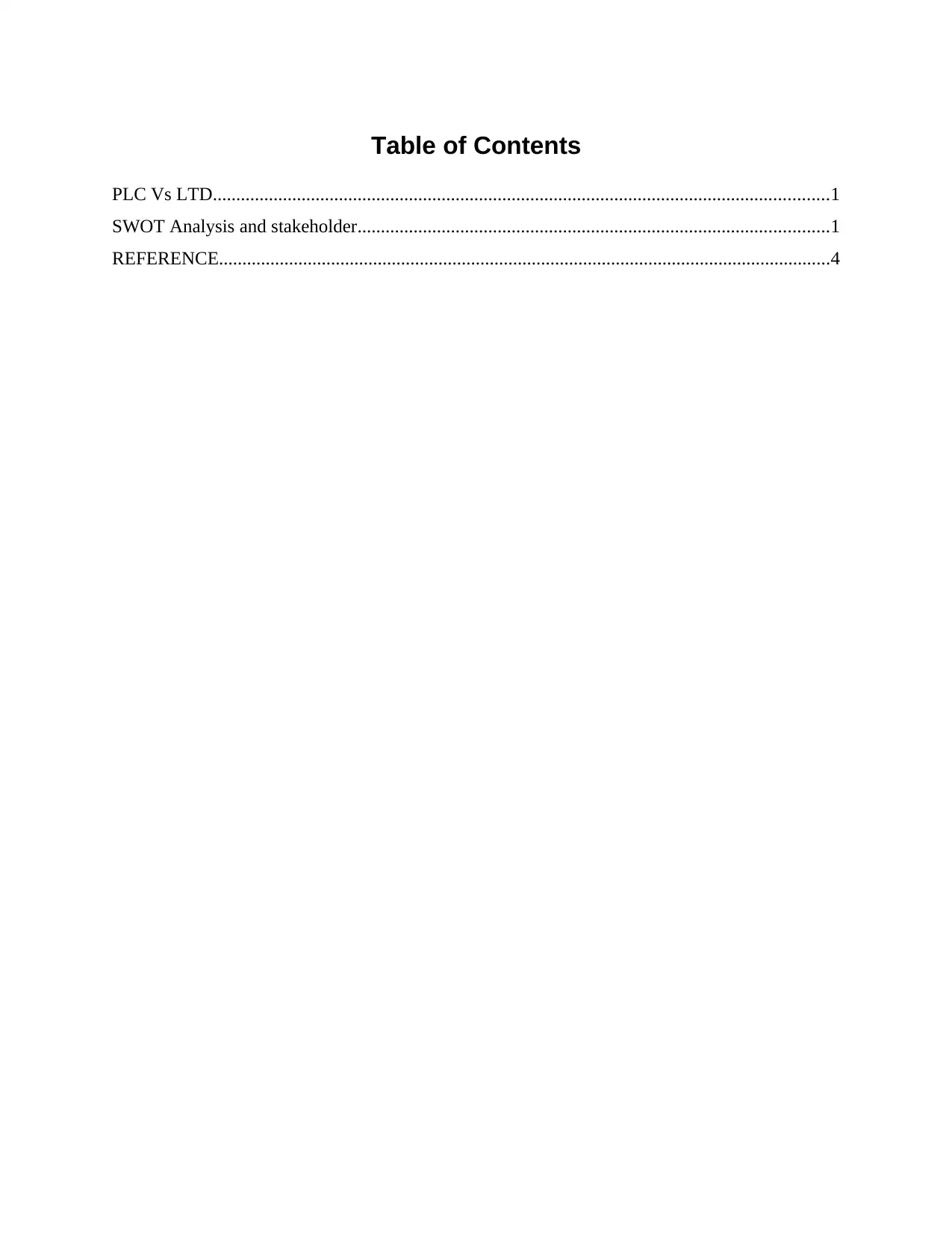
Table of Contents
PLC Vs LTD....................................................................................................................................1
SWOT Analysis and stakeholder.....................................................................................................1
REFERENCE...................................................................................................................................4
PLC Vs LTD....................................................................................................................................1
SWOT Analysis and stakeholder.....................................................................................................1
REFERENCE...................................................................................................................................4
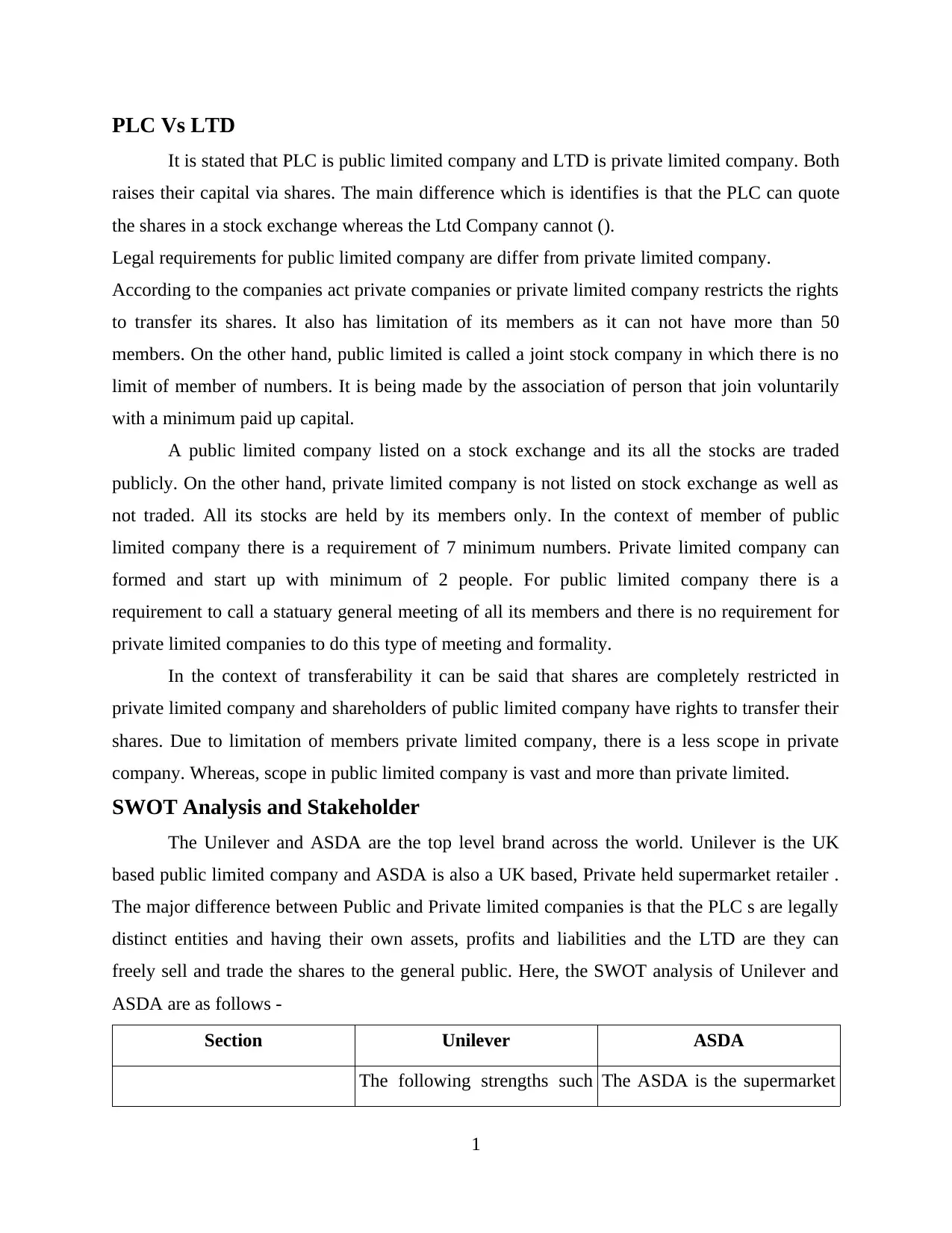
PLC Vs LTD
It is stated that PLC is public limited company and LTD is private limited company. Both
raises their capital via shares. The main difference which is identifies is that the PLC can quote
the shares in a stock exchange whereas the Ltd Company cannot ().
Legal requirements for public limited company are differ from private limited company.
According to the companies act private companies or private limited company restricts the rights
to transfer its shares. It also has limitation of its members as it can not have more than 50
members. On the other hand, public limited is called a joint stock company in which there is no
limit of member of numbers. It is being made by the association of person that join voluntarily
with a minimum paid up capital.
A public limited company listed on a stock exchange and its all the stocks are traded
publicly. On the other hand, private limited company is not listed on stock exchange as well as
not traded. All its stocks are held by its members only. In the context of member of public
limited company there is a requirement of 7 minimum numbers. Private limited company can
formed and start up with minimum of 2 people. For public limited company there is a
requirement to call a statuary general meeting of all its members and there is no requirement for
private limited companies to do this type of meeting and formality.
In the context of transferability it can be said that shares are completely restricted in
private limited company and shareholders of public limited company have rights to transfer their
shares. Due to limitation of members private limited company, there is a less scope in private
company. Whereas, scope in public limited company is vast and more than private limited.
SWOT Analysis and Stakeholder
The Unilever and ASDA are the top level brand across the world. Unilever is the UK
based public limited company and ASDA is also a UK based, Private held supermarket retailer .
The major difference between Public and Private limited companies is that the PLC s are legally
distinct entities and having their own assets, profits and liabilities and the LTD are they can
freely sell and trade the shares to the general public. Here, the SWOT analysis of Unilever and
ASDA are as follows -
Section Unilever ASDA
The following strengths such The ASDA is the supermarket
1
It is stated that PLC is public limited company and LTD is private limited company. Both
raises their capital via shares. The main difference which is identifies is that the PLC can quote
the shares in a stock exchange whereas the Ltd Company cannot ().
Legal requirements for public limited company are differ from private limited company.
According to the companies act private companies or private limited company restricts the rights
to transfer its shares. It also has limitation of its members as it can not have more than 50
members. On the other hand, public limited is called a joint stock company in which there is no
limit of member of numbers. It is being made by the association of person that join voluntarily
with a minimum paid up capital.
A public limited company listed on a stock exchange and its all the stocks are traded
publicly. On the other hand, private limited company is not listed on stock exchange as well as
not traded. All its stocks are held by its members only. In the context of member of public
limited company there is a requirement of 7 minimum numbers. Private limited company can
formed and start up with minimum of 2 people. For public limited company there is a
requirement to call a statuary general meeting of all its members and there is no requirement for
private limited companies to do this type of meeting and formality.
In the context of transferability it can be said that shares are completely restricted in
private limited company and shareholders of public limited company have rights to transfer their
shares. Due to limitation of members private limited company, there is a less scope in private
company. Whereas, scope in public limited company is vast and more than private limited.
SWOT Analysis and Stakeholder
The Unilever and ASDA are the top level brand across the world. Unilever is the UK
based public limited company and ASDA is also a UK based, Private held supermarket retailer .
The major difference between Public and Private limited companies is that the PLC s are legally
distinct entities and having their own assets, profits and liabilities and the LTD are they can
freely sell and trade the shares to the general public. Here, the SWOT analysis of Unilever and
ASDA are as follows -
Section Unilever ASDA
The following strengths such The ASDA is the supermarket
1
⊘ This is a preview!⊘
Do you want full access?
Subscribe today to unlock all pages.

Trusted by 1+ million students worldwide
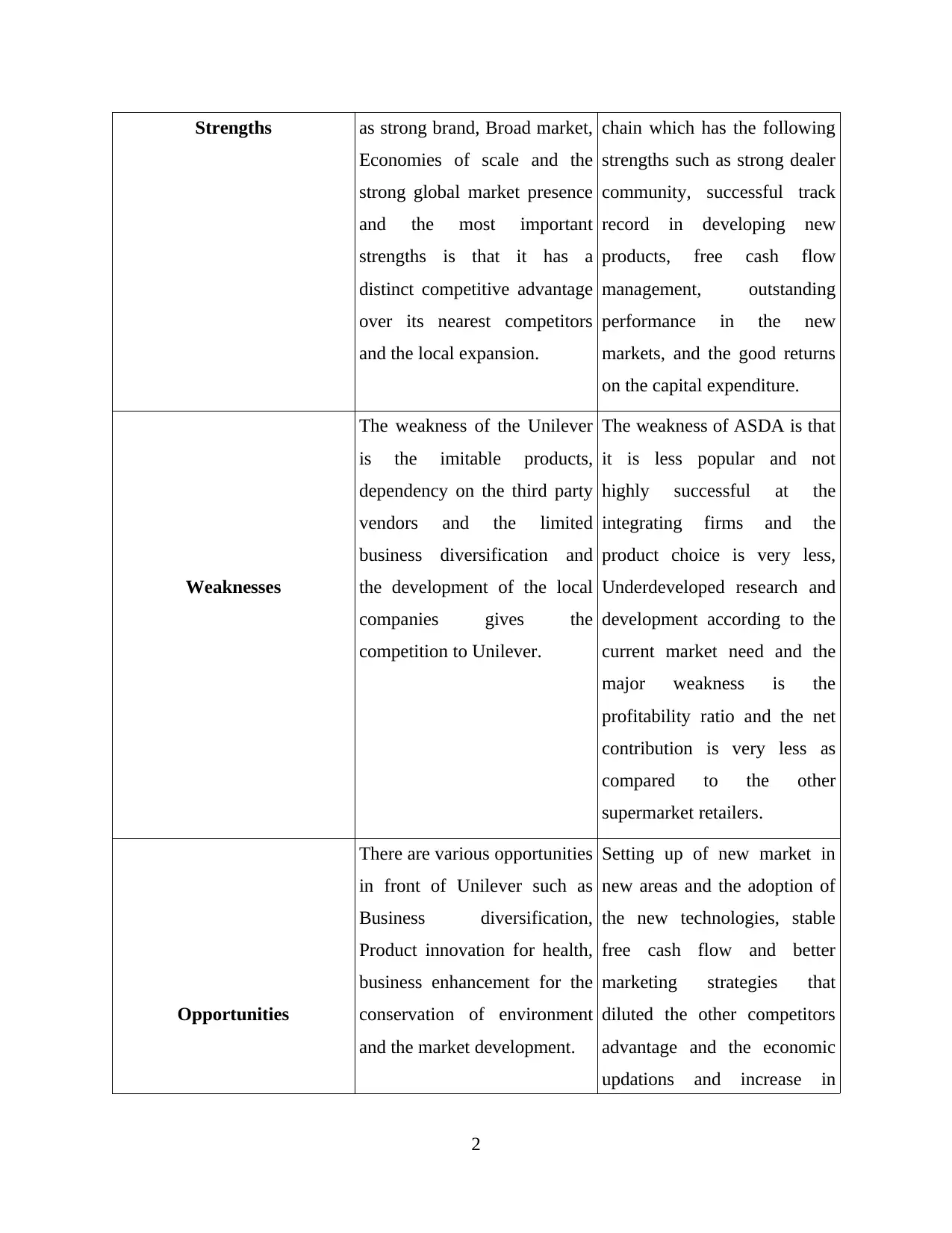
Strengths as strong brand, Broad market,
Economies of scale and the
strong global market presence
and the most important
strengths is that it has a
distinct competitive advantage
over its nearest competitors
and the local expansion.
chain which has the following
strengths such as strong dealer
community, successful track
record in developing new
products, free cash flow
management, outstanding
performance in the new
markets, and the good returns
on the capital expenditure.
Weaknesses
The weakness of the Unilever
is the imitable products,
dependency on the third party
vendors and the limited
business diversification and
the development of the local
companies gives the
competition to Unilever.
The weakness of ASDA is that
it is less popular and not
highly successful at the
integrating firms and the
product choice is very less,
Underdeveloped research and
development according to the
current market need and the
major weakness is the
profitability ratio and the net
contribution is very less as
compared to the other
supermarket retailers.
Opportunities
There are various opportunities
in front of Unilever such as
Business diversification,
Product innovation for health,
business enhancement for the
conservation of environment
and the market development.
Setting up of new market in
new areas and the adoption of
the new technologies, stable
free cash flow and better
marketing strategies that
diluted the other competitors
advantage and the economic
updations and increase in
2
Economies of scale and the
strong global market presence
and the most important
strengths is that it has a
distinct competitive advantage
over its nearest competitors
and the local expansion.
chain which has the following
strengths such as strong dealer
community, successful track
record in developing new
products, free cash flow
management, outstanding
performance in the new
markets, and the good returns
on the capital expenditure.
Weaknesses
The weakness of the Unilever
is the imitable products,
dependency on the third party
vendors and the limited
business diversification and
the development of the local
companies gives the
competition to Unilever.
The weakness of ASDA is that
it is less popular and not
highly successful at the
integrating firms and the
product choice is very less,
Underdeveloped research and
development according to the
current market need and the
major weakness is the
profitability ratio and the net
contribution is very less as
compared to the other
supermarket retailers.
Opportunities
There are various opportunities
in front of Unilever such as
Business diversification,
Product innovation for health,
business enhancement for the
conservation of environment
and the market development.
Setting up of new market in
new areas and the adoption of
the new technologies, stable
free cash flow and better
marketing strategies that
diluted the other competitors
advantage and the economic
updations and increase in
2
Paraphrase This Document
Need a fresh take? Get an instant paraphrase of this document with our AI Paraphraser
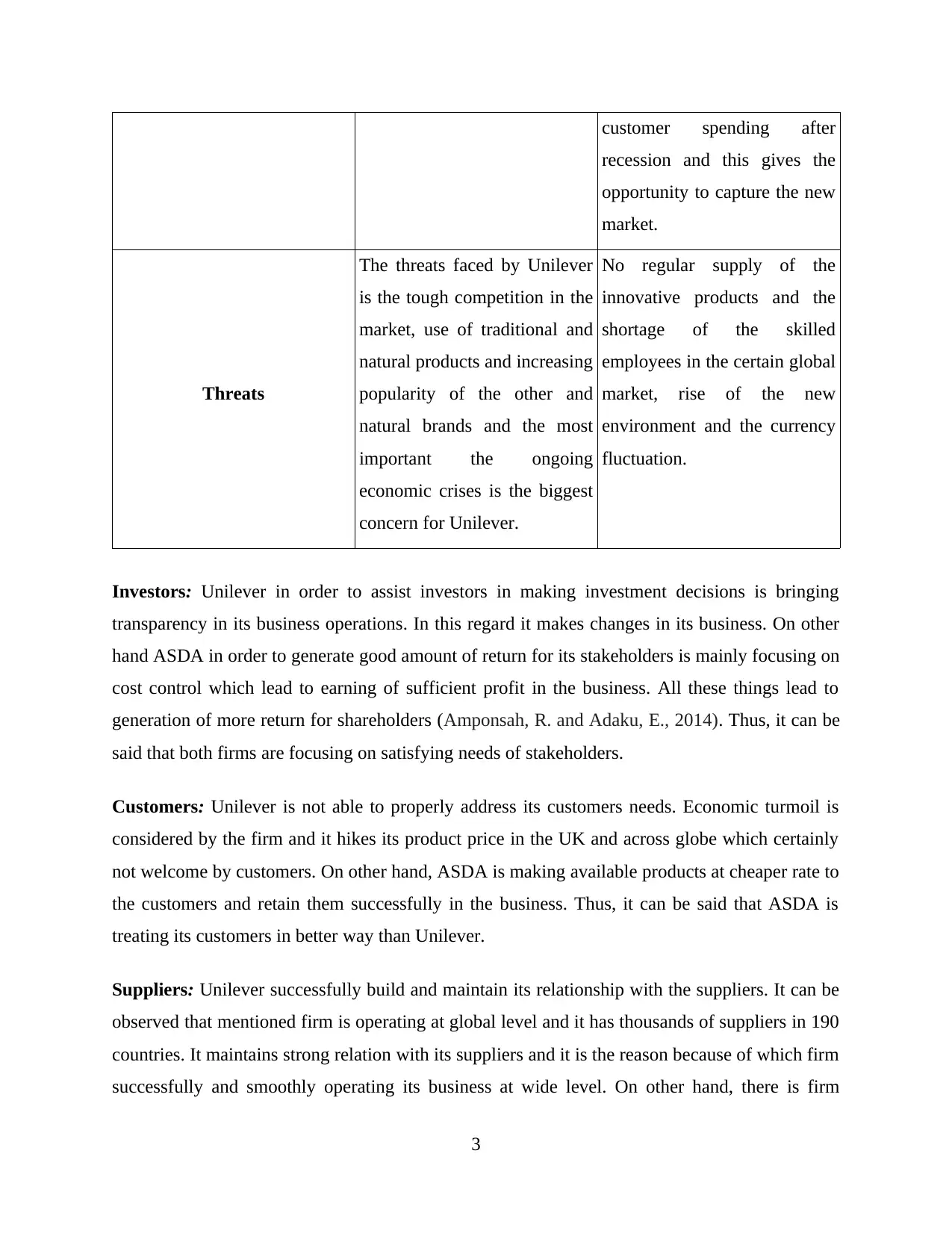
customer spending after
recession and this gives the
opportunity to capture the new
market.
Threats
The threats faced by Unilever
is the tough competition in the
market, use of traditional and
natural products and increasing
popularity of the other and
natural brands and the most
important the ongoing
economic crises is the biggest
concern for Unilever.
No regular supply of the
innovative products and the
shortage of the skilled
employees in the certain global
market, rise of the new
environment and the currency
fluctuation.
Investors: Unilever in order to assist investors in making investment decisions is bringing
transparency in its business operations. In this regard it makes changes in its business. On other
hand ASDA in order to generate good amount of return for its stakeholders is mainly focusing on
cost control which lead to earning of sufficient profit in the business. All these things lead to
generation of more return for shareholders (Amponsah, R. and Adaku, E., 2014). Thus, it can be
said that both firms are focusing on satisfying needs of stakeholders.
Customers: Unilever is not able to properly address its customers needs. Economic turmoil is
considered by the firm and it hikes its product price in the UK and across globe which certainly
not welcome by customers. On other hand, ASDA is making available products at cheaper rate to
the customers and retain them successfully in the business. Thus, it can be said that ASDA is
treating its customers in better way than Unilever.
Suppliers: Unilever successfully build and maintain its relationship with the suppliers. It can be
observed that mentioned firm is operating at global level and it has thousands of suppliers in 190
countries. It maintains strong relation with its suppliers and it is the reason because of which firm
successfully and smoothly operating its business at wide level. On other hand, there is firm
3
recession and this gives the
opportunity to capture the new
market.
Threats
The threats faced by Unilever
is the tough competition in the
market, use of traditional and
natural products and increasing
popularity of the other and
natural brands and the most
important the ongoing
economic crises is the biggest
concern for Unilever.
No regular supply of the
innovative products and the
shortage of the skilled
employees in the certain global
market, rise of the new
environment and the currency
fluctuation.
Investors: Unilever in order to assist investors in making investment decisions is bringing
transparency in its business operations. In this regard it makes changes in its business. On other
hand ASDA in order to generate good amount of return for its stakeholders is mainly focusing on
cost control which lead to earning of sufficient profit in the business. All these things lead to
generation of more return for shareholders (Amponsah, R. and Adaku, E., 2014). Thus, it can be
said that both firms are focusing on satisfying needs of stakeholders.
Customers: Unilever is not able to properly address its customers needs. Economic turmoil is
considered by the firm and it hikes its product price in the UK and across globe which certainly
not welcome by customers. On other hand, ASDA is making available products at cheaper rate to
the customers and retain them successfully in the business. Thus, it can be said that ASDA is
treating its customers in better way than Unilever.
Suppliers: Unilever successfully build and maintain its relationship with the suppliers. It can be
observed that mentioned firm is operating at global level and it has thousands of suppliers in 190
countries. It maintains strong relation with its suppliers and it is the reason because of which firm
successfully and smoothly operating its business at wide level. On other hand, there is firm
3
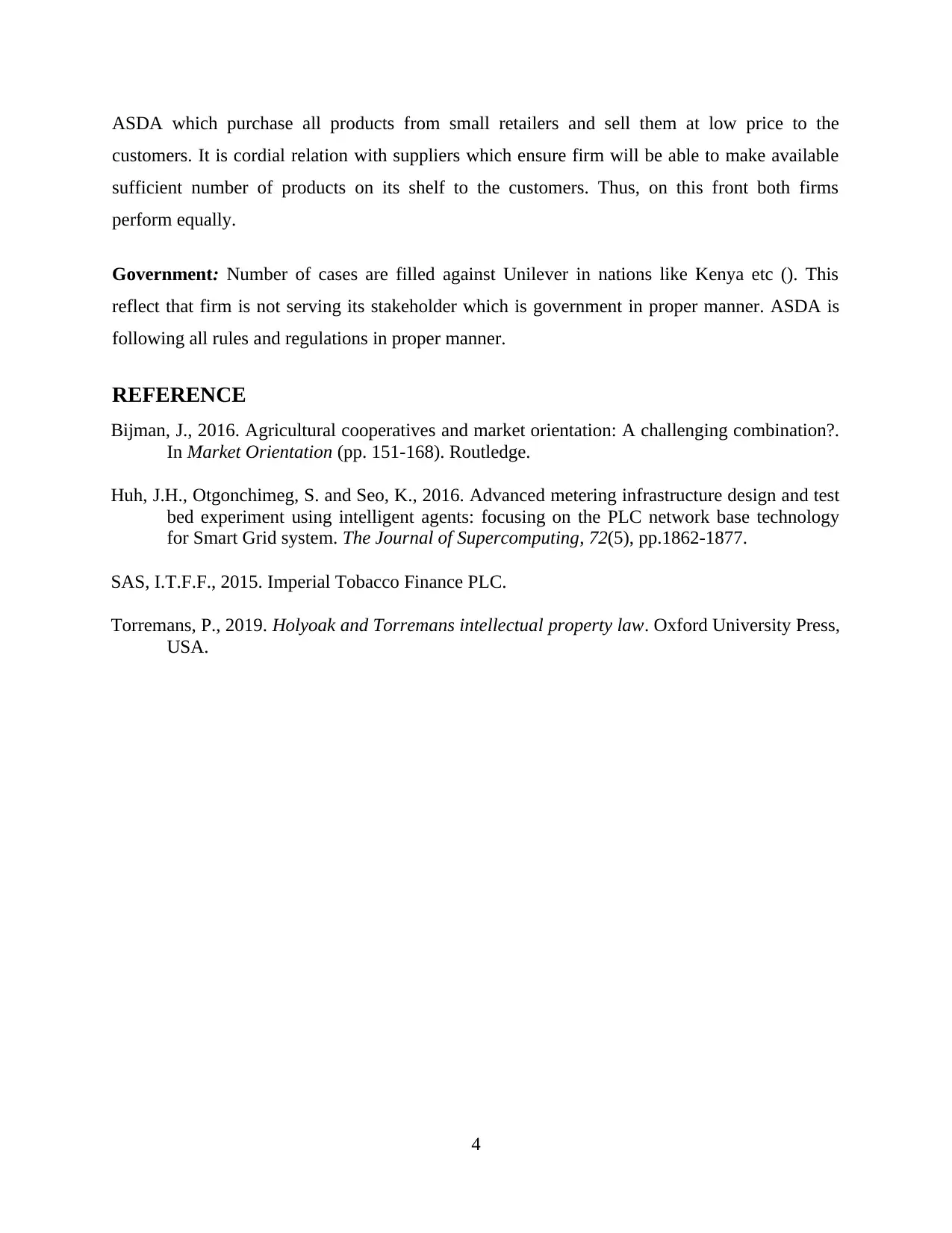
ASDA which purchase all products from small retailers and sell them at low price to the
customers. It is cordial relation with suppliers which ensure firm will be able to make available
sufficient number of products on its shelf to the customers. Thus, on this front both firms
perform equally.
Government: Number of cases are filled against Unilever in nations like Kenya etc (). This
reflect that firm is not serving its stakeholder which is government in proper manner. ASDA is
following all rules and regulations in proper manner.
REFERENCE
Bijman, J., 2016. Agricultural cooperatives and market orientation: A challenging combination?.
In Market Orientation (pp. 151-168). Routledge.
Huh, J.H., Otgonchimeg, S. and Seo, K., 2016. Advanced metering infrastructure design and test
bed experiment using intelligent agents: focusing on the PLC network base technology
for Smart Grid system. The Journal of Supercomputing, 72(5), pp.1862-1877.
SAS, I.T.F.F., 2015. Imperial Tobacco Finance PLC.
Torremans, P., 2019. Holyoak and Torremans intellectual property law. Oxford University Press,
USA.
4
customers. It is cordial relation with suppliers which ensure firm will be able to make available
sufficient number of products on its shelf to the customers. Thus, on this front both firms
perform equally.
Government: Number of cases are filled against Unilever in nations like Kenya etc (). This
reflect that firm is not serving its stakeholder which is government in proper manner. ASDA is
following all rules and regulations in proper manner.
REFERENCE
Bijman, J., 2016. Agricultural cooperatives and market orientation: A challenging combination?.
In Market Orientation (pp. 151-168). Routledge.
Huh, J.H., Otgonchimeg, S. and Seo, K., 2016. Advanced metering infrastructure design and test
bed experiment using intelligent agents: focusing on the PLC network base technology
for Smart Grid system. The Journal of Supercomputing, 72(5), pp.1862-1877.
SAS, I.T.F.F., 2015. Imperial Tobacco Finance PLC.
Torremans, P., 2019. Holyoak and Torremans intellectual property law. Oxford University Press,
USA.
4
⊘ This is a preview!⊘
Do you want full access?
Subscribe today to unlock all pages.

Trusted by 1+ million students worldwide

5
Paraphrase This Document
Need a fresh take? Get an instant paraphrase of this document with our AI Paraphraser

6

7
⊘ This is a preview!⊘
Do you want full access?
Subscribe today to unlock all pages.

Trusted by 1+ million students worldwide

8
1 out of 10
Related Documents
Your All-in-One AI-Powered Toolkit for Academic Success.
+13062052269
info@desklib.com
Available 24*7 on WhatsApp / Email
![[object Object]](/_next/static/media/star-bottom.7253800d.svg)
Unlock your academic potential
Copyright © 2020–2025 A2Z Services. All Rights Reserved. Developed and managed by ZUCOL.





